
views
Babbling Basics

Have a conversation. Take the time to sit down and have engaged, deliberate conversations with your baby. Focus on your baby as he or she speaks, just as you would focus on any other conversational partner you might have. Sit in front of your baby and look directly into his or her eyes as you speak. Alternatively, sit with your baby in your lap or carry your little one around as you converse. Converse with your baby at every opportunity. When you change your little one's diaper or feed your baby, for instance, talk through the activity. Conversations with your baby will likely consist of both babbles and "real" speech. If you don't know what to say, say anything. Tell your baby about your plans or ask rhetorical questions. Your baby may not understand the words, but he or she will learn how to respond to different inflections and intonations.

Repeat after your baby. When your baby begins to babble, repeat his or her babbles. Each “ba-ba-ba” your baby makes should be followed with a “ba-ba-ba” of your own. Repeating after your baby's babbles will let your little one know that you are giving him or her your undivided attention. Since your baby wants your attention, he or she is likely to babble more often in an effort to keep it. Similarly, you can respond to your baby's babbles with unrelated expressions that let your baby know you're listening. After a string of babble, you could excitedly respond with "I see!" or "Really!"

Introduce new babbling sounds. After your baby finishes his or her own babbles, introduce similar sounding babbles. For instance, after repeating your baby's “ba-ba-ba,” follow by saying something like “bo-bo-bo” or “ma-ma-ma.” You could also follow up your baby's babbles with simple words that contain the same sound as the babble your baby just made. For example, if your baby says, "bah," you could respond with "bah-bah-ball." If your baby says "dah," you could reply with "dah-dah-dog."

Speak slowly and simply. Whether you are repeating babbles or using real words, you should be slow and deliberate as you speak to your baby. Your baby will begin to understand your speech before mastering speech of his or her own. Simplifying your own speech will make the learning process easier and encourage your baby to keep vocalizing. Some studies suggest that babies learn to babble partially because they engage in lip-reading as they watch you speak. By slowing down your words and forming them deliberately, you allow your baby a greater opportunity to observe the movements of your mouth and repeat them.

Be positive. When your baby babbles, demonstrate excitement and happiness. Reacting positively to your baby's babbles will let your child know that babbling is a good thing and something that should be repeated more often. Aside from using a positive tone of voice, you should also speak praise phrases, like "Good job!" Nonverbal communication is also important. Smile, laugh, clap your hands, and wave. Both verbal and nonverbal expressions of excitement are necessary if you want to show your baby that babbling is a positive thing.

Keep talking. Talk to your baby as often as possible, even when you are not engaged in an active conversation with him or her. Babies have a tendency to mimic, and simply listening to your voice on a regular basis can encourage them to use their own voice more often. Talking encourages both receptive and expressive language. Receptive language is the ability to understand speech, and expressive language is the ability to make speech. Talk to yourself and talk to your baby as you go about your everyday tasks. When you wash the dishes, talk about the chore and the different dishes you wash as you handle them. Even if your baby is looking elsewhere, your little one is still listening as long as he or she is awake.

Change your tone. As you speak throughout the day, change the way you speak by varying the volume and pitch. A change in your voice will grab your baby's attention and pique further interest in the vocalization process. Your baby will likely get used to the sound of your voice. Suddenly speaking in a different voice will usually cause your little one to refocus his or her attention on you in an effort to understand how that different sound is being made. This works especially well if you speak in a “silly” voice. No matter how you change your tone, though, keep it positive.
Additional Activities
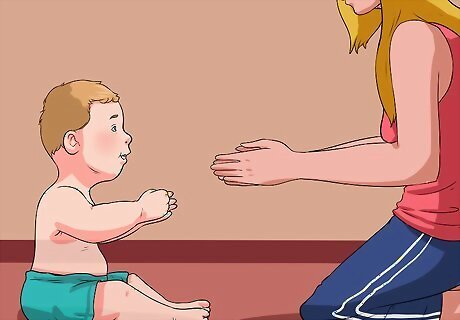
Teach your baby simple commands. Even though your baby is only babbling now, it is still a good idea to begin instructing your baby in simple terms. Provide instructions that encourage your baby to interact with his or her world. For instance, try teaching your baby something like “kiss mama” or “hug daddy.” When you give your baby instructions, follow through by showing him or her what those instructions mean. Say "bounce ball" and bounce the ball. Your baby may not be able to perform the action immediately, but once your little one gains the ability to do so, he or she will be thrilled to both do the action and know what that action is.

Emphasize single words. When you speak to your baby, place emphasis on certain words you want to highlight by saying them more deliberately, clearly, and loudly. Emphasizing a single word within a string of several words will help your baby comprehend those words sooner. When choosing a word to emphasize, pick an object rather than an action or descriptive term. Language has more meaning at this age when it is related to a tangible object.
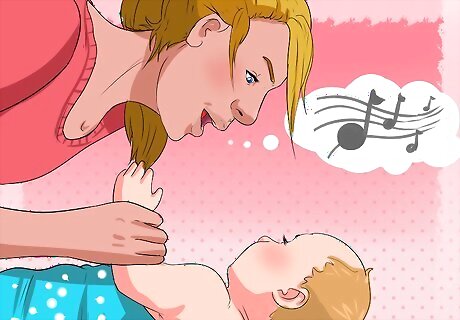
Sing to your baby. You can sing classic children's songs like “Twinkle, Twinkle, Little Star” or “Bingo,” but you can also sing by simply speaking to your baby in a sing-song voice on occasion. Most babies enjoy the sound of singing and will attempt to babble and sing back. You don't need to limit yourself to kids' songs, either. Singing your own favorites can be just as effective. Singing to your baby presents language in a manner that differs from basic speech. This variation can help further your baby's understanding of language and may boost development. It can also be helpful to pick one song to use whenever you need to comfort your baby. After a few repetitions, your baby will learn to calm down as soon as the song starts. This also teaches your baby that speaking and singing are positive behaviors.
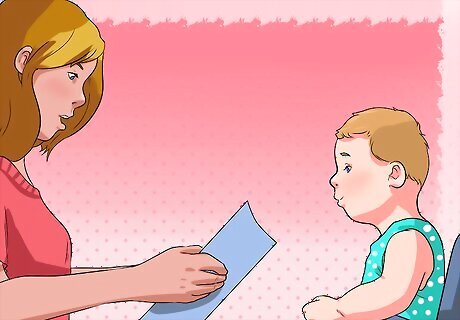
Read aloud. Buy children's books and read them to your baby on a frequent basis. Your little one may not understand everything yet, but the gears in your baby's head will start to turn. The auditory aspect of this activity will encourage your baby to babble, while the visual aspect could encourage your child to take more of an interest in reading later in life. Make sure that you choose books aimed at your baby's age. In this stage, the best books are picture books with bright colors and a lot of contrast. The words should be simple and easy to understand. Reading picture books to your baby also creates a cognitive link between the 3D and 2D world since you are teaching your baby to associate real objects with pictures of those objects.
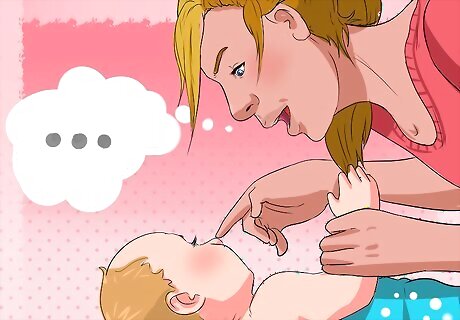
Assign names. Babies are naturally curious about the world around them. Label parts of your baby's world by pointing at them and repeating that object's name. Doing this can help your child become more interested in repeating those names, which can encourage your baby to further his or her babbling skills. A good labeling activity to begin with is the labeling of body parts. Point to your baby's nose and state, "nose." Point to your baby's hand and state, "hand." Most babies are naturally curious about their own bodies, and describing the body will encourage your baby to babble in imitation of your descriptions. You can also name people, like "Mama," "Daddy," "Grandma," and "Grandpa." If you have pets, label the pets, as well. When starting out, label the pet by type rather than individual name, e.g., "dog" instead of "Spot." Any object that is part of your baby's usual environment can work, especially if your baby is already looking at it. You can label anything from "tree" to "ball."

Tell a story. Use your imagination to come up with a story and tell it to your baby. Storytelling naturally requires you to use different intonations and expressions, and the excitement in your voice can get your baby curious enough to repeat after you in babble form. Mix things up by telling a simple story one day and an elaborate one the next. The more you vary your stories, the more engaged your baby will become.
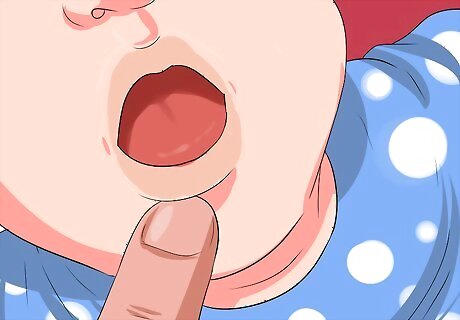
Gently pat your baby's mouth. When your baby is only just starting to babble, try lightly patting his or her mouth each time your baby makes a certain babble sound. Later on, lightly pat your baby's mouth before he or she starts to babble. Oftentimes, a baby will connect your action with the babbling activity from earlier and may repeat the earlier babble as you pat his or her mouth. Your baby may even begin moving his or her mouth or repeating the same babble sounds when you stop patting to encourage you to start up again. This activity can be used with any baby learning to babble, but it can be especially helpful if your baby struggles with strength in his or her facial muscles.

Use props and tools. Engaging your baby's visual sense while you work on your little one's verbal abilities can enhance the development of both. Some tools can be used to help your baby learn the names of different objects. For instance, you could tell your baby a story about a cat and use a cat puppet as you speak. Other tools will simply make the act of speaking more interesting to your baby. For instance, a baby might see you speak on your own phone, then babble into a toy telephone as a way of mimicking your actions.

















Comments
0 comment